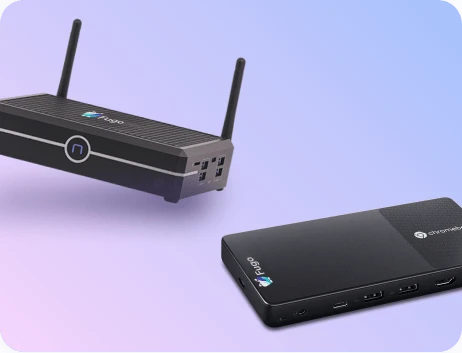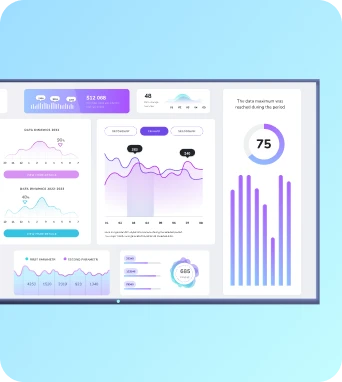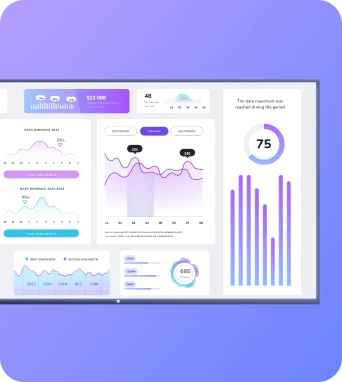Sure, AI can whip up college essays, paint cats like Van Gogh, or write bedtime stories in iambic pentameter. But your boss doesn’t care if ChatGPT can rhyme about procurement delays. It’s also not helping you clear your inbox or stay ahead of Monday’s status meeting. 😅
See, most AI tools are long in the hype department, and a bit short in terms of output. But the good news is, you can use AI assistants to pick up the slack and tie all of your mission-critical tools together.
If you’re on the hunt for AI that, well, works for work — like making dashboards, meeting prep, inbox triage, and dealing with data cleanup — you can use this guide to decide on the most efficient AI assistant capabilities.
Struggling to pick the best one(s) for your tech stack? We offer a super simple decision framework at the bottom of the guide.
Welcome to the AI assistant tsunami
Let’s start by defining our terms.
AI assistants, sometimes called AI virtual assistants or AI agents, are software programs that help you automate tasks across multiple tools or platforms. It’s a combination of various types of AI models — think machine learning, natural language processing (NLP), and conversational AI — to help you complete time-consuming tasks that may have been better spent elsewhere.
AI assistants are powered by large language models (LLMs), which are trained on massive datasets to understand natural language and generate human-like responses. To make an AI assistant, you just need to combine an LLM with a few other key components:
1. Prompt parsing: The assistant breaks down your input to understand what you’re actually asking. For example, “make me a dashboard of Q2 sales” is translated into specific tasks like querying data or formatting visuals.
2. Tool integration: Many assistants are connected to third-party tools like Google Sheets, Slack, or CRMs. They can use tools like APIs to pull in real-time data, execute actions, or generate objects like charts on your behalf.
3. Agents and memory: More advanced assistants connect with other agents (called autonomous agents) that can plan, execute, and adjust multi-step tasks. The best of the best have a fairly long memory, meaning they can reference past user interactions or recall user preferences.
4. User interface (UI) layering: Some AI assistants can answer your questions inside your existing tools, like checking off a box in Asana, for example. Others can spin up their own interfaces. For example, it might generate a custom conversational AI interface so you can read and respond to questions in the app.
TL;DR: AI assistants work by understanding user needs and connecting with tools to complete complex tasks.
AI assistance has existed for decades, but it’s only been a few years since it’s really hit the big leagues. These days, there are literally hundreds of tools available to choose from, from Chrome extensions to Copilot clones to everything in between.
And finding a great AI assistant is worth its weight (er, code?) in gold.
The benefits speak for themselves.
AI assistants can help with:
- Overcoming challenges like human error
- Automate routine tasks so you can spend more time on other things
- Eliminating human intervention with tasks like data analysis
- Providing end-to-end encryption to ensure data security
- Interacting with users and providing human-like responses (aka conversational AI)
- Identifying patterns and offering recommendations based on user behavior
But that doesn’t mean every AI assistant is worth its salt. You and I both know that most are fairly, ah, lukewarm at best.
We’re all familiar with AI tools that talk a big game about saving time, only to offer some souped-up chatbot that takes 10 minutes to answer a yes/no question. If it can’t perform tasks based on the basic parameters you give it, then no, it’s probably not up for more complex tasks.
Too many bots and not enough results make Jack and Jill very frustrated customers. You deserve an AI agent that can help with the nitty-gritty at work, from automating routine tasks to scheduling meetings to answering questions without human intervention.
On that note, let’s take a look at some AI assistant capabilities that can genuinely move the needle forward for your business.
8 AI assistant capabilities you never knew you needed
If you’re on the hunt for AI assistants offering genuine task-based productivity, then you need to find tools that offer a basic set of features.
Feeling overwhelmed? No worries: we’ve done the heavy lifting for you. 😉
Here are eight AI assistant capabilities you should look for in any potential AI assistant tool.
1. Direct integrations
In the ancient days, before GPTs roamed the earth, the only way to set up automations was to manually connect all your systems with code.
So thank goodness we have better methods these days. This includes leveraging the power of AI assistants to automatically perform tasks across multiple tools and systems.
For example, you might let your AI assistant connect with:
- Google Workspace or Microsoft 365. This will let you summarize docs, update Sheets, or auto-schedule calendar events with just a prompt.
- Project management tools like Asana. That way, you can perform tasks like data analysis, automatically assign work, and otherwise enhance productivity by instantly crossing to-dos off the list.
- CRMs like Salesforce or HubSpot. Instead of digging through records and past interactions on your own, your assistant can pull up a customer’s full history and draft a follow-up email in seconds (more on this later).
- Field service tools like Fieldcamp. This will let you automate scheduling across various field reps based on location, skills, and route.
Now just think about all the productivity gains you can get from the right integration, especially if you start tracking time saved by slashing repetitive tasks.
Case in point: AI can improve employee productivity by 66%, largely in part to automating processes.
2. Multi-step logic
More powerful AI agents use something called multi-step logic, which is the ability to chain complex tasks requiring multiple steps. That means your AI assistant doesn’t just respond to a support ticket; it can tag it, escalate it, update the CRM, and notify the right team.
Now, imagine using multi-step logic for other mission-critical tasks, like enhancing the employee experience. For example:
- A team member requests time off
- Your AI virtual assistant checks their PTO balance
- It updates the calendar and alerts their manager
It can also make magic happen on the customer’s side, like if you need to smooth over potentially rocky interactions. Like so:
- A customer submits a refund request
- Your AI virtual assistant verifies the order
- It flags exceptions and kicks off a refund process via your billing tool
If your AI assistant can’t handle multi-step logic, it’s less of an assistant and more of a glorified GPT.
Thankfully, you can tap into tools like Google Assistant that can help you set up multistep flows.
3. Prompt memory
With prompt memory, your AI assistant can retain past inputs and use them to shape better. This means more personalized responses in future interactions, without needing you to repeat yourself every time you want a specific outcome.
For example, let’s say you ask your assistant to draft a customer onboarding email whenever a new employee gets added to your HR management system. Later, you say, “Use the same tone as the onboarding email, but write one for their one-month check-in.”
A strong AI system with prompt memory will be able to adapt its workflow to your needs.
You should also know that prompt memory can help with more operational tasks. This might include:
- Tracking ongoing projects across multiple check-ins
- Recalling a stakeholder’s preferred meeting times
- Carrying forward customer preferences or previous issues
Not sure where to find digital assistants like this? You might explore fast-growing tools like ChatGPT, Google Assistant, Fugo AI, and enterprise copilots with memory APIs.
4. Charts and dashboards output
Your AI assistant should be able to generate more than text and pictures — like charts, dashboards, or even UIs that help you see what’s happening across your business.
That way, you can ask questions (like, “what were our top three sales channels last quarter?”) and let your AI agent create a tidy little chart so you can display data and find trends in seconds.
Imagine how this might work across departments:
- Human Resources: Monitor headcount or PTO data with a sleek organizational chart
- Finance: Visualize revenue, spend, or CAC vs CLTV in an all-in-one single dashboard
- Sales: Track deal velocity, conversion rates, or quota attainment over time
- Marketing: Display campaign performance by channel, region, or persona, even if your data's spread across multiple locations
Your AI agent can fetch the details across departments by grabbing data across multiple tools. And with tools like Fugo, you can even publish them in the same place.
Which leads to our next point…
5. Output-oriented generation
Output-oriented generation basically means your AI agent can give you finished work instead of a template to work from. It’s basically designed to develop ready-to-publish content, like digital signage visuals, weekly digests, or dashboards that don’t need extra formatting.
Just imagine all the possibilities:
- A recruiter’s KPI dashboard that shows time-to-hire, pipeline health, and candidate conversion rates
- A support team’s CSAT monitor, auto-generated from Zendesk tags and updated daily
- A RevOps leader’s metrics digest, emailed every Monday with churn stats and win/loss breakdowns
And when you layer on a visual-first assistant — like Fugo AI — you can publish those outputs directly to screens around the office, digital signage dashboards, or even exec laptops.
Otherwise, you can use tools like Google Sheets to make a chart or dashboard, then push it to a laptop, company TV channel, or digital signage dashboard.
And speaking of publication…
6. Content delivery
Content delivery is exactly what it sounds like: once your AI assistant has material, it can figure out where to send it. This makes it easy to send finished copies of work to project management tools, internal software, and other places where it can be seen.
Let’s pretend you’re setting up a digital signage program for your business. With your AI agent, you can set up digital signage integrations that push content to everywhere your team needs to be in real-time. This could be sending KPIs through Slack notifications, Notion embeds, email reports, and even conference room TV screens, which makes it easy to keep your whole team in the loop.
Just imagine using AI assistants to provide mission-critical metrics that let your team work smarter, faster. That way, you can brainstorm next steps, boost your task completion rates, and otherwise put more repetitive work on autopilot.
7. Service assistants
Many AI agents can be converted into service assistants, which are designed to step in to handle real-world tasks in specialized environments. Unlike basic chatbots, these assistants are trained on proprietary data, meaning they’re carefully constructed around your specific use case..
There are all sorts of applications to choose from here:
Medical
Imagine building an AI model with multilingual support. This can help patients communicate better with emergency room staff and other medical professionals.
Executive assistants
AI personal assistants can help manage your calendar, book travel, and even connect with smart home devices to help manage incoming calls on your behalf (more on this later).
Customer service
Some AI agents can use automatic speech recognition to understand voice commands and let callers perform self-service tasks, like paying bills over the phone. You might also use digital assistants to generate scripted responses, then send quick text messages to clients to give your customer support agents a break.
Legal
AI tools can draft templates, summarize contracts, and scan documents for key risks, which frees you up to do more important, higher-leverage tasks.
Rating systems for AI interactions can help validate productivity and ROI. For example, if you notice your customer service score goes up after implementing an AI assistant service, you can be reasonably certain it’s related to your software — and then show off your results by pushing the details to a digital signage dashboard. 😉
8. Streamline workflows
Streamlining workflows with AI just means reducing the steps it takes to get something done, especially the repetitive or boring ones that slow everyone down.
There are lots of different applications for this depending on your industry or specific department:
Office administration
For example, you might streamline administrative tasks like:
- Managing schedules
- Meeting scheduling
- Answering questions
Human resources (HR)
Sure, you can use conversational assistants to help with HR tasks, but you can also tap into workflows
- Candidate interviews, like scheduling meetings
- Internal help desk requests, like “what’s the new PTO policy?”
- Other administrative tasks, like candidate pre-screening
Customer communications
You can use artificial intelligence to help support (not replace) customer support agents by removing some of the burden and automated repeat workflows.
This includes things like AI voice agents, for example, which can pick up the phone whenever you’re busy or out for the day. This means you don’t have to worry about being away from your phone: your AI assistant can pick up and answer customers 24/7, 365.
You can also manage mundane customer service tasks with tools like:
- Call transcriptions
- Email summaries
- Automated replies or trigger messages
AI virtual assistants are basically a huge quality of life upgrade for struggling customer service teams that need to take some weight off.
How to pick the right AI assistant
We’ve covered a lot of ground so far. But what if you’re struggling to make a tough choice?
So what separates the great AI assistants from the relatively hum-drum ones? 🤔
Here’s an easy framework you can use to evaluate your options:
- Purpose-built vs. general: General-purpose assistants are great for casual tasks, but they often fall short for industry-specific work. With this in mind, you should look for tools you can train on internal data (think sales numbers, ops processes, or internal documentation) rather than just Reddit threads and Wikipedia articles.
- Embedded in your workflow vs. siloed from your tools. AI is most powerful when it meets you where you work. That’s why the best assistants plug directly into the tools you already use so you’re not juggling apps or manually copy-pasting between tabs.
- Generates output vs. offers suggestions. Generative AI is pretty good at helping you brainstorm, but it’s not always able to help you create finished content. A strong AI assistant can help you span the gap by building dashboards, sending follow-up emails, or creating a project timeline from a conversation.
- Understands context vs. starts from scratch every time. High-functioning AI assistants use memory, user preferences, and integrated context (like past chats, recent tasks, or business rules) to give you more relevant support. In other words, it can help you get more done in a day without needing you to re-explain things over and over.
From chat to charts with Fugo.ai
The key difference between a good and great AI assistant is the many advanced capabilities it can offer. No need to settle for Claude or GPT: These days, you can set up systems that let the two of them run on autopilot.
And don’t you worry — Fugo’s getting in on the action, too. 😎 We’re on a mission to change digital signage with AI agents designed to make screen-ready visualizations you can ship to Slack, email, or your office TV.
We’re talking:
- Prompt-based dashboards
- Context memory that grows with you
- Trigger-based automations
- Smart content generation
- Prompt-to-slide AI flow
But why read all about it when you can try it instead?
Sign up today for the Fugo AI Beta Program and explore how AI assistants can help you build digital signage faster.
Frequently asked questions about AI assistant capabilities
Q: What can an AI assistant do?
You can use AI assistants for automating tasks between multiple platforms or AI tools. First, there’s generative AI, which can help you generate content (think images, text, charts, and more). Then, there’s task automation: the ability to put mundane tasks on autopilot. Data entry falls into this category. You can also create workflows that enhance productivity, like finding optimal time slots for meetings or translating past data into multiple languages.
Q: What are the 4 capabilities of AI?
First is reactive machine AI, which is designed for very specific tasks (like the Netflix recommended movies algorithm).
Next is limited memory AI, which has some, but not much, retentive memory of user inputs. This is the category most basic AI assistants fall into.
Third is Theory of Mind AI, which can personalize its responses for human-like interactions. Keep in mind this is purely theoretical and has never actually been designed in the real world.
Finally, we have self-aware AI, which might be the closest we could get to a truly ‘human’ machine. This is even more theoretical than Theory of Mind AI, and there’s no way to know if it’s even possible with existing technology. But scientists are still working on making an artificial intelligence that goes far and beyond basic personal assistants.
Q: What are the capabilities of Adobe AI assistant?
You can use Adobe AI assistant to summarize PDFs and make decisions in less time. For example, you might read through generative summaries instead of entire documents, easily understand complex terms and ideas in contracts, or use the chat function to analyze data across multiple documents and tabs.
Q: What are the features of an AI voice assistant?
A voice AI assistant uses natural language processing and machine learning to answer complex queries without human intervention. Translation: it manages tasks you verbally tell it to do. Voice assistants work by translating a human voice into text, synthesizing user commands, then assigning tasks to other digital tools to accomplish the goal — like generating charts for your marketing or sales team.





